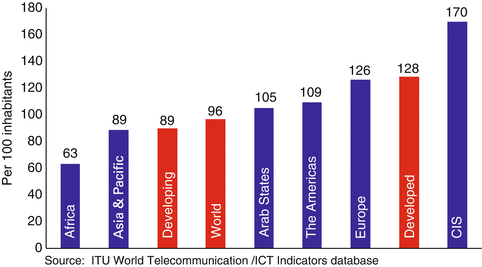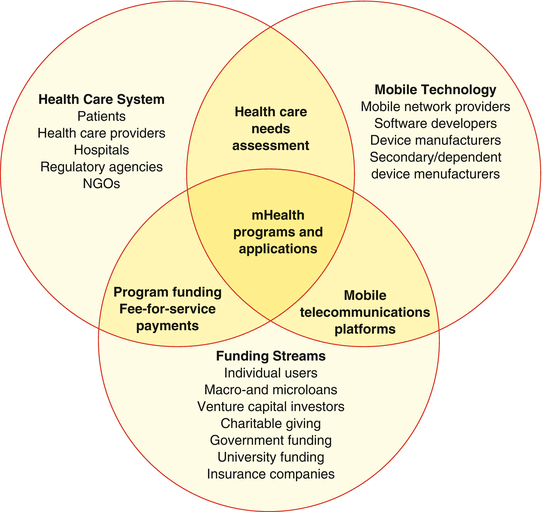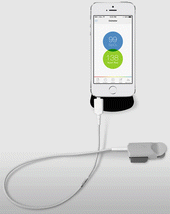Fig. 29.1
Worldwide mobile cellular subscriptions relative to population. Worldwide, the number of mobile cellular subscriptions approaches the population, demonstrating the increasingly universal access to cellular technology. Source: International Telecommunications Union (Branch of United Nations)

Fig. 29.2
Mobile subscriptions per 100 inhabitants by region. In some countries, it is common for people to hold more than one cellular subscription (e.g. one for personal use and one for business use), while in other countries, families, or communities may share a subscription or a device. Note: Commonwealth of Independent States (CIS). Source: International Telecommunications Union (Branch of United Nations)
Because of the accessibility of mobile technology, industries such as banking that provide exclusively mobile services are growing exponentially in the lowest income countries. In 2013, 52 % of mobile money accounts were located in sub-Saharan Africa, and there were nine countries in sub-Saharan Africa where citizens held more mobile money accounts than bank accounts [6]. This technology can and is being applied in the health care industry in the form of mHealth initiatives. Mobile devices can be used to monitor heart rate and oxygen saturation, and inroads are being made in other diagnostic and imaging modalities. Indeed the use of mHealth tools is one area where the gap between high income countries (HICs) and low and middle income countries (LMICs) is narrow—the World Health Organization (WHO) noted in 2011 that 77 % of LMICs and 87 % of HICs had implemented mHealth initiatives [3]. According to Google Trends, interest in mHealth is increasing and is highest outside of high income countries (See Figs. 29.3 and 29.4) [7]. The first section in the chapter explores the application of mHealth to surgical quality and perioperative medicine.



Fig. 29.3
Google Trends Search Index shows interest in mHealth is growing. The Google Trends search index shows the relative number of searches for a given term relative to the maximum number of searches for that term. For example, if the term “health” was searched 10,000 times in 2010 that would correspond to a search index of 100. It demonstrates growing or waning international interest in a given topic. For the term “mHealth” interest spiked after 2009 and has been growing steadily. Trend prediction for the year 2015 is included

Fig. 29.4
Google Trends Search Index of mHealth by country. The Google Trends Search Index by country shows the relative number of searches for the term mHealth worldwide. The country with the most searches is indexed as 100
Personal computing and internet access lag behind access to mobile technology—especially in low- and middle-income countries (LMICs). For example only 7 % of households in Sub-Saharan Africa have internet access allowing 16 % of the population to be online [4]. The biggest barrier to expanding internet access in LMICs is cost; internet access costs 31 % of the gross national income per capita (GNI p.c.) in LMICs versus 1.7 % of GNI p.c. in high income countries [4].
However, because of Facebook, Google, and other internet giants, “poorer countries in Asia, Africa, and Latin America represent the biggest opportunity to reach new customers” [8]. The industry is poised to change. With its $19 billion purchase of WhatsApp, a platform that uses the internet to send information via smartphones, and their participation in the Internet.org initiative, Facebook made an investment in expanding Internet access in LMICs via smartphones in 2013 [9]. As Internet costs continue to decrease and mobile Internet access continues to increase, Internet educational platforms such as Massive Open Online Courses (MOOC) and real-time data-gathering become more accessible. The second section in this chapter addresses the global health applications of Internet-based learning and public health surveillance.
Finally, the flipside of transparency and access is lack of privacy. In the last section the emerging issues of digital professionalism and privacy in a global health context are explored.
mHealth: What Is It, and How Does It Apply to Surgical Care in Global Health?
The mHealth Landscape
Mobile communication-based health care applications, programs and technologies are collectively known as mHealth. According to the World Bank, mHealth applications run on any mobile device from a cellphone to a smartphone to a tablet and fulfill one or more of the following health care functions:
Improving management and decision making by health care professionals.
Real-time and location-based data gathering.
Provision of health care to remote and difficult-to-serve locations.
Fostering learning and knowledge exchange among health professionals.
Promoting public health.
Improving accountability.
Improving patient health self-management [3].
mHealth programs can take a variety of forms—from SMS messaging feeding real-time data into a national database in India to mobile applications helping patients count calories in the US or keep track of drug therapies in Haiti to reminders for appointments at a hospital in Kenya [3, 10, 11]. As described in Fig. 29.5, a variety of stakeholders contribute to the development and implementation of mHealth initiatives. Often mHealth initiatives are joint public and private ventures [3, 10, 12, 13].


Fig. 29.5
The majority of mHealth programs initiated thus far focus on communicable diseases, health care systems, and behavioral health. Of the projects registered with the mHealth Institute at Johns Hopkins University, only 7 of the 118 address surgical diseases and none specifically address perioperative medicine (see Table 29.1) [14]. A similar pattern holds true for the 2014 mHealth Summit, a joint industry-government conference hosted by the Health Information and Management Systems Society (HIMSS) in conjunction with the National Institutes of Health (NIH). Panels will separately address the role of mHealth in programs and policy in domestic hospital medicine and initiatives for different populations in global health, but no sessions specifically address surgical diseases in global health [15]. Thus far surgical care and perioperative medicine have been in the periphery of the larger mHealth conversation with projects such as:
Table 29.1
mHealth projects registered at Johns Hopkins University Global mHealth Initiative, grouped by area
Content area | Number of projects |
|---|---|
Systems, education, and behavior | 50 |
Communicable diseases | 43 |
Noncommunicable diseases | 18 |
Surgical diseases | 7 |
RapidSMS helps local officials in remote areas who have low technical literacy monitor UNICEF supply chains through SMS messaging. In the transition from paper-based data collection to SMS-based data collection, the data quality improved—discrepancies decreased from 14.2 to 2.8 % [3].
The medAfrica app created by a Kenyan company Shimba Technologies, Ltd. aims to “increase access to health related content and services to save lives and build healthy populations with the aim of reaching every household in Africa.” Through this app, patients with surgical diseases can find location-based screening or consultation services with one of Kenya’s 7,000 doctors [16].
Anyone in the world can have a dermatology consultation within 24 h through the iDoc24 iOS, Android, or web platform. The user takes a picture of his/her skin issue, uploads the picture, describes associated symptoms, pays the $39.00 USD fee, and receives a response from a remotely located dermatologist within 24 h [17]. Though this fee is out of the reach of most citizens of LMICs, given that 90 % of patients with HIV will have skin manifestations, climate change will make skin cancer more prevalent, and that most of the lowest income countries have few if any dermatologists, iDoc24 offers an interesting model for increasing access [18].
These projects just scratch the surface of what is possible in surgical care and perioperative medicine through mHealth. Using eHealth and mHealth technology, local and visiting surgeons and anesthesiologists in low-resource settings can enhance education and support for health care providers, strengthen infrastructure and data management systems, and offer actual health care services such as pre-procedure evaluation and postoperative follow-up. In the next two sections we address some of the mHealth technologies available for anesthetic care in a low resource setting and offer examples of possible applications.
SMS Messaging in mHealth: Low Tech, Cheap, and Versatile
Every cellular device manufactured for use over current commercial networks has the ability to use the Send Message Service (SMS) to send or receive a 160-character text message. SMS messages can also be sent or received by a computer. It is a push technology, which means that SMS messages are received by the user’s device without any action from the user [10]. Though SMS messaging was designed for person-to-person communication, it can also be used by outside entities to connect with customers or, in the case of health care, patients. Because SMS messages can be sent to and processed by a computer with larger data management capabilities, SMS messages can be easily turned into data for logging behaviors, physiologic data, or operations information.
SMS messaging has been used by mHealth programs and applications for sending appointment reminders and personalized health tips or education materials, documenting supply chains, and, in its most advanced form, goal tracking [10]. Goal tracking incorporates both the data gathering function, wherein a patient sends an SMS message noting behavior, symptoms, or physiologic parameters to a computer application which processes this information in the context of the patient’s health goals, and sends an SMS message advancing or affirming these goals. SMS message goal tracking has been applied in the context of smoking cessation [19], but because smartphone technology lends itself well to goal tracking, SMS-based mHealth initiatives in perioperative medicine are not found in the literature. Several mHealth programs for goal tracking and medication compliance in solid organ transplant patients or free-flap patients in the U.S. have been designed for use with smartphones [20]. But, in areas like sub-Saharan Africa where SMS messaging is a high penetrance technology and smartphones are a low penetrance technology, these types of initiatives could be undertaken with SMS. For patients, an SMS message goal tracking application might be useful in encouraging rehabilitation exercises for orthopedic surgery patients in areas where outpatient physical therapy is not available or feasible. For providers, studies in Kenya and Uganda have shown improvement in health care workers’ compliance with medical guidelines after use of SMS-based mHealth applications [21], and this could be used to encourage compliance with evidence based guidelines for perioperative care.
Physiologic Monitoring and Diagnostics via Smartphone
In the 2009 blockbuster movie Star Trek, which takes place in the twenty-third century AD, the starship’s flight doctor points a device that looks remarkably similar to a handheld retail store barcode scanner at a crew member’s forehead to accurately measure several physiologic variables and diagnose an infectious disease within seconds. In real life, mobile mHealth diagnostics moves closer to science fiction every day. Currently smartphone and Bluetooth compatible pulse oximeters, heart rate monitors, spirometers and ultrasound machines are on the market. Some of the devices currently available, their compatibility, and current uses are detailed below.
There are several smartphone compatible pulse oximeters on the market. Masimo released the iSpO2™ device and companion app for iPhone in late 2013 and expanded to the Android platform in 2014. iSpO2™ is a dual wave pulse oximeter, and the app provides the pulse rate as well as a perfusion index and can trend, store, and transmit 12 h of data. It weighs under a pound and currently retails on Amazon.com for $149–139 USD. There are several personal-use grade pulse oximeters available such as the iChoice™ from ChoiceMed (compatible with iOS, retails for $69 USD) and the iOximeter™ from SafeHeart (compatible with iOS and Android platforms, retails for $69 USD).
Recognizing the potential global health benefits of smartphone compatible pulse oximeters, the Government of Canada partnered with Canadian angel investor and entrepreneur Irfhan Rajani to expand the development and manufacture of the smartphone-, tablet-, and computer-compatible Kenek O2™ (its prototype was the Phone Oximeter™) from LionsGate Technologies for use in global health settings. The Kenek O2 pulse oximeter, like the iSpO2™ has been validated across a range of peripheral blood oxygen saturation values versus traditional stand-alone oximeters [22]. LionsGate Technologies has developed a full line of mobile device compatible monitors (see Fig. 29.6) including blood pressure cuff, heart rate, and temperature probe, each of which are designed for a global health setting [23]. Such large scale investment in smartphone compatible monitors coupled with the upcoming production of cheaper smart phones aimed at LMIC markets by the Mozilla Foundation could translate to increased availability of standard anesthesia monitors in global health settings [9]. The combined cost of the Mozilla smartphone and the LionsGate Technologies Kenek O2™ would be $65 USD, which is 1/100th of the cost of a stand-alone portable pulse oximeter.



Fig. 29.6
The Phone Oximeter™ was designed by Lionsgate Technologies and is being developed for global health uses through a $2 million USD grant from the Government of Canada and a private investor. Source: Lionsgate Technologies

Fig. 29.7
The majority of eHealth and mHealth applications used by anesthesiologists are used for logging, quick access to reference material, and online learning
Other devices with potential applications for anesthesiology providers in global health settings that are currently on the market include:
The MobiUS™ SP1 smartphone compatible ultrasound by MobiSante was approved for patient use by the U.S. Food and Drug Administration (FDA) in 2012. The MobiUS™ probe runs off of the auxillary port of a specialized smart phone (they come as a package) and can store and transmit the 8 MB ultrasound images over a WiFi connection [24]. While the device portability will appeal to anesthesiologists looking to offer regional anesthetics or invasive vascular access in remote settings, the price point is less appealing at $7500 USD.
SpiroSmart is a smartphone application that uses a specialized microphone attached to a smartphone to measure the forced expiratory volume in 1 s (FEV1), forced vital capacity (FVC), and peak expiratory flow (PEF) with 5.1 % mean error as compared to traditional spirometry [25]. Developed by researchers at the University of Washington, the cost is less than $100 USD compared to the cheapest traditional portable spirometry apparatus at $1,000 USD or stand-alone module at $5,000 USD.
Researchers at the Henry Samueli School of Engineering and Applied Science at the University of California in Los Angeles (UCLA) have developed a smartphone-based wide-field microscope and flow cytometer [26], which could help improve access to pathology services in the diagnosis of surgical diseases and could have implications for cheap end-tidal gas sampling.
eHealth and mHealth for Anesthesiology Education and Data Management
We [Coursera] have close to 2 million students worldwide right now. A third of them are in the United States, and two-thirds are outside, including many in developing countries where this is really the only access to education that they are ever likely to have.Stay updated, free articles. Join our Telegram channel

Full access? Get Clinical Tree






